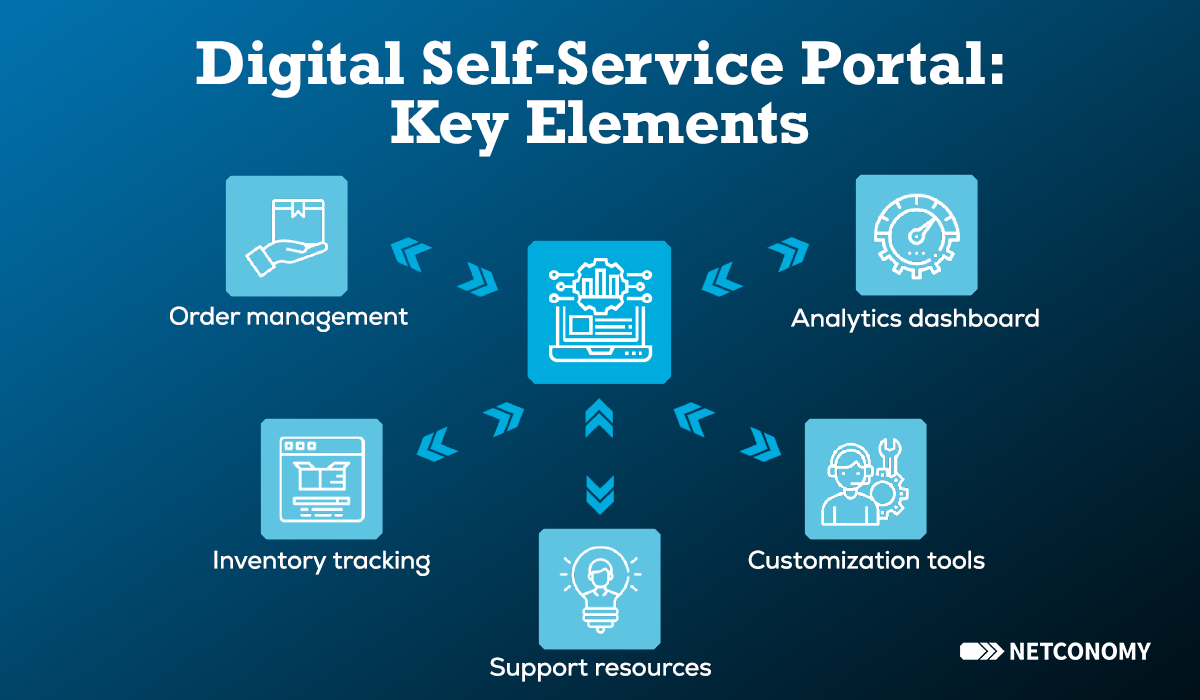
Why CEOs in Manufacturing Are Turning to Digital Self-Service for Growth

What if the strategies that once made your manufacturing business successful are now holding you back? Traditional systems and processes – once the backbone of manufacturing – are struggling to keep up with the modern B2B landscape.
First off, customers demand speed, convenience, and personalization – qualities not often associated with manufacturing. Combine that with rising costs, economic uncertainty, and the pressure of digital transformation, and the need for change becomes clear.
Many forward-thinking CEOs are now adopting digital self-service platforms to meet customer expectations, enhance operational efficiency, and stay competitive in a rapidly changing market.
In this article we’ll cover:
- What is a digital self-service portal?
- How digital self-service drives growth in manufacturing
- Next steps for CEOs considering digital self-service
What is a Digital Self-Service Portal?
A digital self-service portal is an online platform that allows customers, partners, and employees to access services and perform tasks independently. Think of it as a central hub where users can:
- place orders
- track shipments
- check inventory
- access technical support
- manage account details
At its core, digital self-service lets your customers take control of their buying experience.
Traditional methods rely on manual interactions and paperwork, which can slow down processes. On the other hand, self-service portals offer 24/7 access, letting users find solutions and complete actions quickly.
This is especially critical in B2B manufacturing, where efficiency and accuracy are crucial for success.
Key Features of Self-Service Portals in Manufacturing
A self-service portal needs to go beyond the basics to truly transform a manufacturing business. Here are some of the must-have features:
- Order Management: Real-time tracking, reordering capabilities, and order history visualization.
- Inventory Tracking: Visibility into current stock levels and estimated timelines for replenishment.
- Support Resources: Access to FAQs, technical documentation, and live chat functionalities.
- Customization Tools: Configurators for personalized products based on individual customer requirements.
- Analytics Dashboard: Insights on customer behavior, order trends, and portal usage metrics.

How Digital Self-Service Drives Growth in Manufacturing
According to Gartner, as many as 75% of B2B buyers prefer a rep-free sales experience. However, the benefits of adopting digital self-service go far beyond customer satisfaction.
Digital-self service helps drive growth in manufacturing by :
- streamlining operations and improving efficiency
- driving revenue
- enhancing customer experience and retention
Streamlining Operations and Improving Efficiency
Self-service platforms are great for reducing manual workload and eliminating bottlenecks. They help automate repetitive low-value processes like order tracking, invoice generation, or inventory management.
By letting customers perform these actions whenever and wherever they want, your teams have more time to focus on strategic tasks that create customer value.
For manufacturing CEOs, this means optimized workflows and more efficient use of resources. According to McKinsey, automation saves businesses up to 20-30% in operational costs – a clear win for any manufacturing leader looking to scale.
By reducing operational expenses, businesses free up resources that can be reinvested in innovation, employee development, and market expansion. Lower costs also improve profitability, giving companies the flexibility to scale and compete more aggressively.
Driving Revenue
Self-service isn’t just about cost-cutting – it also increases revenue. By implementing a self-service portal, customers can explore an interactive product catalog, customize designs using a configuration tool, and instantly view pricing based on their selections.
This streamlined experience empowers the customer and reduces friction in the purchasing process. With the help of AI-powered recommendation engines, the platform can even suggest additional products based on browsing history or past orders.
As a result, more customers complete their orders online without requiring sales assistance, leading to a noticeable increase in order volume and overall revenue for the company.
Additionally, offering a superior digital experience gives you a competitive edge. The easier it is for customers to do business with you, the more likely they will choose your products over your competitors.
Enhancing Customer Experience and Retention
Every customer loves speed and convenience. So, with faster response times and greater transparency, buyers stick around longer and are more likely to become repeat customers. These are all crucial in B2B manufacturing where every customer counts and losing just one can cripple your business.
A self-service portal ensures quick access to essential services without relying on back-and-forth communication. Features like real-time shipment tracking and instant customer support enhance trust and loyalty.
In addition, you can personalize your portal to specific customer roles or teams, reducing the clutter and ensuring everyone on the customer’s side has access only to features relevant to their job.
Collectively, these advancements drive revenue growth, strengthen the company’s competitive edge, and establish a foundation for sustained success in the market.
Next Steps for CEOs Considering Self-Service Portals
If you keep clinging to how you’ve “always done it,” you risk falling behind competitors who can adapt more quickly to economic shifts and customer needs.
To help you get started, here are some steps you can take towards building digital self-service in your company.
Evaluate Your Digital Maturity
Start by assessing your organization’s current processes and pain points. Are manual, repetitive tasks slowing you down? Are customers demanding faster, more digital interactions? If so, it’s time to consider a self-service portal.
Use Data to Inform Decisions
Leverage existing customer insights to prioritize features your customers will find most valuable. What pain points do they report most frequently? Address these areas first for maximum impact.
Start Small, Scale Strategically
The transition to digital self-service doesn’t have to overhaul your entire operation all at once. Instead, start small: focus on specific, high-impact touchpoints like order tracking or invoicing. Build from there.
Invest in the Right Technology
Partner with platforms that offer seamless integration between your existing systems and new self-service capabilities.
SAP provides a strong foundation for digital self-service by seamlessly connecting front-office and back-office data using its integration suite and the flexibility of the SAP Business Technology Platform (BTP).
Implementing such solutions requires advanced technology and a deep understanding of business models and tailored approaches.
This is where experienced partners like NETCONOMY play a key role, helping you design and deliver creative solutions that maximize the potential of SAP’s tools.
These combined strengths create a framework that supports efficient and effective digital self-service initiatives.
Take Action Today
Wondering where to start? We’ve created an in-depth guide, ‘Digital Self-Service as a Central Point of a B2B Relationship‘ to help you discover how digital self-service can position your organization as a market leader.
Authors and Contributors

Martin Barzauner | Chief Executive Officer








